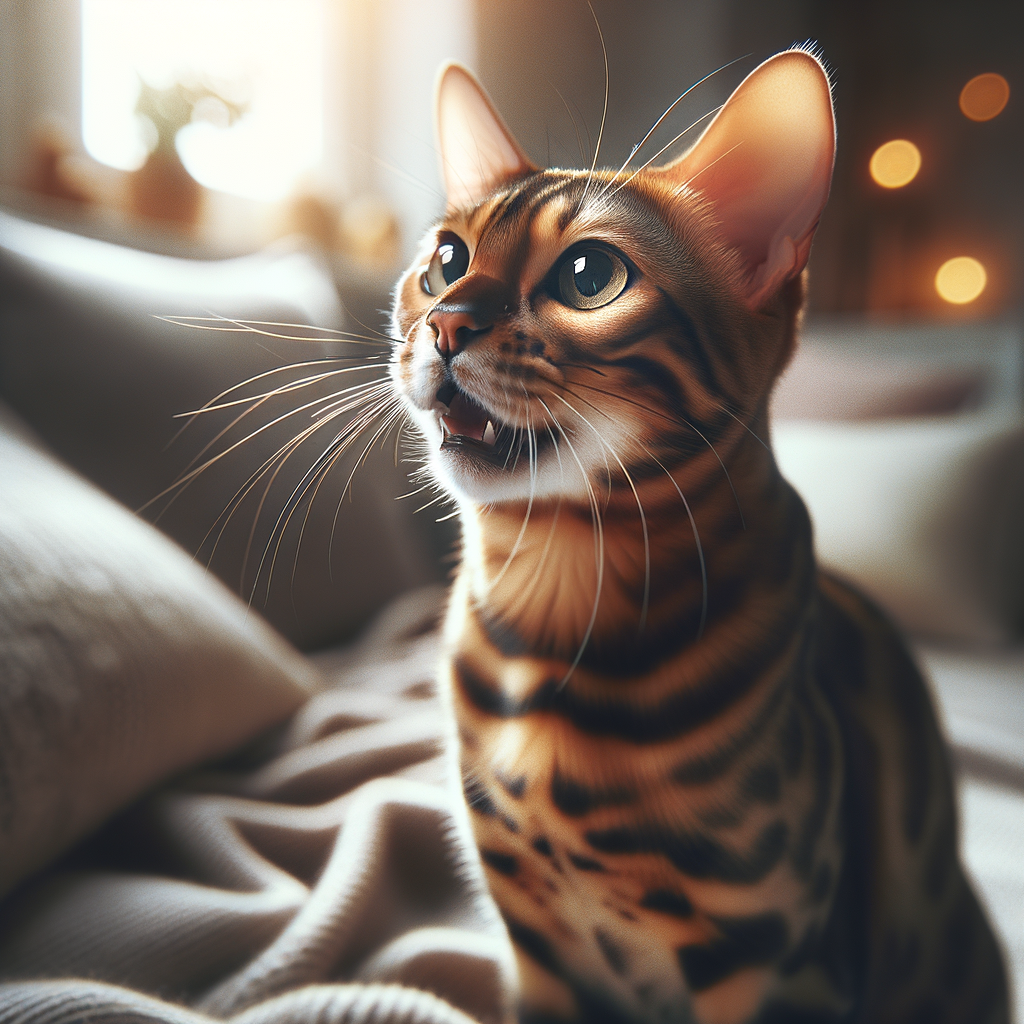
Introduction to Bengal Cat Vocalization
- Overview of Bengal cat sounds: Bengal cats are known for their unique and varied vocalizations. They don’t just meow; they chirp, yowl, and even make sounds that resemble human speech. These sounds can be quite different from those of other cat breeds.
- Importance of understanding Bengal cat communication: Knowing what your Bengal cat is trying to say can help you meet their needs better. It can also strengthen your bond with your pet. Understanding their sounds can alert you to their mood, health, and even if they are hungry or want to play.
Understanding Bengal Cat Sounds
Common Bengal Cat Noises
- Bengal cat meowing: Bengal cats are known for their distinctive meows. Unlike other cats, their meows can be louder and more frequent. They use meowing to communicate with their owners, often to express needs like hunger or attention. According to a study by the Journal of Veterinary Behavior, Bengal cats meow more often than other breeds.
- Bengal cat chirping: Another unique sound Bengal cats make is chirping. This noise is similar to a bird’s chirp and is often heard when they are excited or hunting. Chirping is a sign of a happy and stimulated Bengal cat. It is a delightful sound that many Bengal cat owners enjoy.
- Other unique Bengal cat noises: Bengal cats also make other sounds like yowling, growling, and purring. Yowling can indicate discomfort or distress, while growling is a sign of aggression or fear. Purring, on the other hand, usually means they are content and relaxed. Each sound has its own meaning and helps owners understand their Bengal cat’s emotions.
Interpreting Bengal Cat Sounds
- What different meows mean: Bengal cats use meows to communicate various needs and emotions. A short, soft meow often means they are greeting you. A loud, insistent meow might indicate they are hungry or need attention. Pay attention to the tone and frequency of their meows to understand their needs better.
- Understanding Bengal cat chirping: Chirping is a unique sound Bengal cats make, often when they are excited or spotting prey, like birds outside the window. This sound is a mix between a meow and a purr and can be quite endearing. It shows their playful and hunting instincts.
- Other Bengal cat vocal habits and their meanings: Bengal cats are known for their wide range of vocalizations. They may trill when they are happy or content. Growling or hissing usually means they feel threatened or scared. Understanding these sounds can help you respond to their needs more effectively.
Bengal Cat Behavior and Vocalization
How Behavior Influences Bengal Cat Vocal Traits
- Behavioral reasons for Bengal cat meowing: They often meow to communicate with their owners. Common reasons include hunger, seeking attention, or expressing discomfort. For example, a Bengal cat might meow loudly if its food bowl is empty or if it wants to play.
- How behavior affects Bengal cat chirping: This sound is often associated with their hunting instincts. When a Bengal cat spots a bird or a toy, it may chirp in excitement. This behavior is a throwback to their wild ancestors who used similar sounds during hunting.
- Other behaviors and their associated sounds: Bengal cats exhibit various behaviors that come with distinct sounds. Purring often indicates contentment and relaxation. Hissing or growling can signal fear or aggression. Understanding these sounds helps in better communication with your Bengal cat.
Behavioral Responses to Bengal Cat Sounds
- How to respond to Bengal cat meowing: Bengal cats meow for many reasons. They might be hungry, bored, or just want attention. When your Bengal cat meows, try to understand what they need. If they are hungry, feed them. If they seem bored, play with them. Sometimes, they just want to be near you.According to Wikipedia, cats use meowing to communicate with humans. So, listen carefully and respond to their needs.
- Responding to Bengal cat chirping: Chirping is a unique sound that Bengal cats make, often when they see birds or other small animals. This sound shows their hunting instincts. When your Bengal cat chirps, it might be excited or trying to get your attention. You can respond by engaging them in play. Use toys that mimic the movement of birds or small animals to satisfy their hunting desire.Chirping can also mean they are happy or curious. So, it’s a good time to bond with your cat.
- Other responses to Bengal cat noises: Bengal cats make various sounds, including purring, hissing, and growling. Each sound has a different meaning. Purring usually means they are content. Hissing or growling can mean they are scared or angry.When you hear these sounds, observe their body language. If they are purring, enjoy the moment. If they are hissing or growling, give them space and try to understand what is bothering them.
| Sound | Meaning | Response |
|---|---|---|
| Meowing | Needs attention, food, or play | Identify the need and respond accordingly |
| Chirping | Excited or hunting instinct | Engage in play with toys |
| Purring | Content and happy | Enjoy the moment |
| Hissing/Growling | Scared or angry | Give space and identify the cause |
Bengal Cat Talking: A Unique Aspect of Bengal Cat Vocalization
- What is Bengal cat talking?
Bengal cat talking refers to the unique way Bengal cats communicate with their owners. Unlike other cats, Bengals are known for their wide range of vocal sounds. They don’t just meow; they chirp, yowl, and even make sounds that resemble human speech.
- Examples of Bengal cat talking
Here are some common examples of Bengal cat talking:
-
-
- Chirping: Bengals often chirp when they see birds or other small animals. It’s a sound of excitement.
- Yowling: This can be a sign of wanting attention or expressing discomfort.
- Trilling: A soft, rolling sound that Bengals use to greet their owners.
- Meowing: Bengals have a distinctive meow that can vary in pitch and length.
-
-
How to encourage and respond to Bengal cat talking
Encouraging your Bengal cat to talk is easy. Here are some tips:
-
-
- Talk back: Respond to your cat’s sounds. This encourages more vocalization.
- Playtime: Engage in interactive play. Bengals often talk more when they are active.
- Positive reinforcement: Reward your cat with treats or affection when they vocalize.
-
Responding to Bengal cat talking is important. Here’s how you can do it:
-
- Understand the context: Pay attention to what your cat is trying to communicate. Are they hungry, playful, or in need of attention?
- Stay calm: If your cat is yowling, stay calm and try to understand the cause. Sometimes, they might just want to be near you.
- Provide comfort: If your cat seems distressed, offer comfort through gentle petting or soothing words.
Embracing Bengal Cat Vocal Habits
- Appreciating the uniqueness of Bengal cat sounds: Bengal cats have a wide range of sounds, from chirps to meows. Each sound has its own meaning, helping you understand what your cat needs or feels.
- Using understanding of Bengal cat vocalization to improve pet-owner relationship: By learning what each sound means, you can respond better to your cat’s needs. This understanding can make your relationship with your Bengal cat more enjoyable and fulfilling.
Pay attention to your cat’s specific sounds and behaviors to get to know them better. This will not only make your cat happier but also make your life as a pet owner more rewarding.






